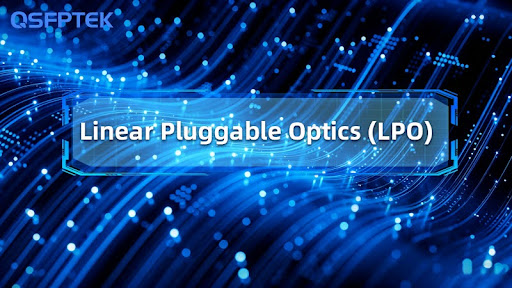In the digital era driven by artificial intelligence and big data, data centers face the dual challenges of explosive growth in computing power and drastically increasing energy consumption. Traditional pluggable optical transceivers rely on digital signal processing (DSP) chips, which, while ensuring signal integrity, come with challenges of high power consumption, high cost, and high latency. Linear Pluggable Optics (LPO), an innovative architecture, removes the DSP chip and offloads signal processing functions to the switch ASIC, significantly reducing power consumption, cost, and latency, making it an ideal solution for short-haul data center interconnects.
Technical Essence: Efficiency Innovation through Architecture Streamlining
LPO is not a radical departure from traditional pluggable optical modules. Instead, it leverages their pluggability while achieving significant performance improvements through architectural optimization. Its core innovations include:
Removing the DSP chip: In traditional optical modules, the DSP is responsible for signal retiming, equalization, and error correction, but it accounts for over 30% of power consumption and over 40% of the cost. LPO retains only analog components such as linear drivers and transimpedance amplifiers (TIAs), offloading signal processing tasks to the host-side switch ASIC.
Linear Analog Technology: Utilizing highly linear drivers and amplifiers, combined with PAM4 modulation technology, directly drives optical devices, ensuring signal integrity over short-distance transmission.
Optimized Thermal Management: Removing the DSP reduces module heat generation, reducing heat dissipation requirements and further reducing cooling energy consumption.
Core Advantages: A Key Enabler of Green Computing Power
LPO’s advantages are reflected in three core areas:
Improved Energy Efficiency: Power consumption is reduced by over 50% compared to traditional solutions. An 800G LPO module consumes only 8-9W, while traditional DSP solutions can consume up to 17W. For hyperscale data centers, this translates to millions of kWh of annual electricity savings and a significant reduction in carbon footprint.
Cost Optimization: Bill of Materials (BOM) costs are reduced by 10%-20%, primarily due to the removal of the DSP chip. In large-scale deployments, this can save hundreds of thousands of dollars in procurement costs for a single cluster.
Latency Compression: Simplified signal transmission paths reduce latency by 10% to 90%. For latency-sensitive applications like AI training, this means shortening training cycles by days and improving cluster computing efficiency.
Application Scenario: The preferred choice for short-distance interconnection in AI computing centers.
LPO is particularly suitable for the following scenarios:
AI/ML clusters: Inter-GPU communication requires high bandwidth and low latency. LPO’s sub-nanosecond latency accelerates distributed training.
Intra-data center interconnection: Short-distance interconnection within or between racks, 0-2 km, is the primary application for LPO.
Edge computing nodes: Its low power consumption makes it suitable for edge environments with limited power and cooling.
Challenges and Responses: Industrial bottlenecks are being overcome
LPO’s large-scale application still faces challenges:
Transmission distance limitations: Without DSP signal compensation, commercial products are generally limited to within 2 km. For distances exceeding 10 km, traditional solutions are still required.
Interoperability requirements: Extremely high signal integrity requirements are imposed on the host side, requiring industry standards to ensure compatibility. The OIF has developed the CEI-112G-LINEAR standard, and the MSA multi-source agreement was released in March 2025 to promote ecosystem unification.
Process Precision Requirements: High-linearity EML lasers and precision temperature control circuits are required, and production yields need to be improved.
Future Evolution: Complementary Development with CPO and Silicon Photonics Technologies
LPO is not an isolated technology; its future evolution path is clear:
Moving Toward Higher Data Rates: The technology can be smoothly upgraded to 1.6T to meet future AI computing power requirements.
Integration with CPO: Co-packaged optics (CPO) is suitable for board-level ultra-short reach (<1m), while LPO covers medium- and short-reach distances of 1m-2km, creating a complementary relationship.
Intelligent Dynamic Compensation: Introducing AI algorithms to adjust signal parameters in real time, compensating for distortion caused by temperature and aging, and enhancing environmental adaptability.
Conclusion: A New Paradigm for Data Center Optical Interconnection
LPO optical modules, through architectural innovation, achieve an optimal balance between performance, power consumption, and cost, becoming critical infrastructure in the era of green computing. With advancements in standardization and process maturity, they will play a core role in 800G/1.6T data centers and AI clusters, driving the shift in optical interconnection from a “performance-first” approach to one that prioritizes both energy efficiency and performance. In the future, the integration of LPO, CPO, and silicon photonics will further reshape the data center network landscape and inject strong momentum into sustainable development.


